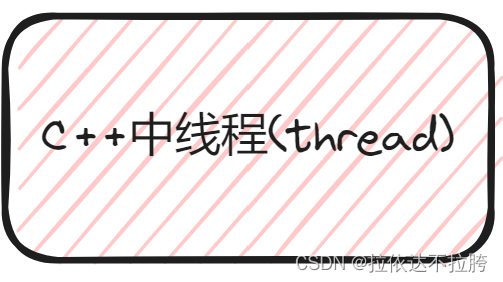C++中线程(thread)原理及使用知识点

每个程序有一个执行 main() 函数的主线程,将函数添加为 std::thread 的参数即可启动另一个线程,两个线程会同时运行。
对于应用程序来说,初始线程起于main(),但对于新线程来说,它起于hello()。
一、std::thread
#include <iostream>
#include <thread>
void hello()
{
std::cout<<"Hello Concurrent World\n";
}
int main()
{
std::thread t(hello);
t.join();
}
每个程序有一个执行 main() 函数的主线程,将函数添加为 std::thread 的参数即可启动另一个线程,两个线程会同时运行。
对于应用程序来说,初始线程起于main(),但对于新线程来说,它起于hello()。
二、合适的线程数量
试图得到系统的最佳性能,考虑可用的硬件并发并调整运行线程的数量是必须的。
对于IO密集型任务:
线程数 = CPU核心数 × (1 + IO耗时 / CPU 耗时)
对CPU密集型任务:
线程数 = CPU 核心数 + 1
三、启动线程
std::thread 的参数也可以是函数对象或者 lambda 表达式
// 1.1
struct A {
void operator()() const { std::cout << 1; }
};
int main() {
A a;
std::thread t1(a); // 会调用 A 的拷贝构造函数
std::thread t2(A()); // most vexing parse,非常棘手的解析,声明函数名为 t2, 参数类型为 A 的函数,而不是启动一个线程。
std::thread t3{A()}; // 改成花括号,使用初始化语法,解决上述的问题
std::thread t4((A())); // 或者多加一层括号避免将其解释为函数声明,从而让t4被声明为一个变量而不是一个函数。
std::thread t5{[] { std::cout << 1; }};
t1.join();
t3.join();
t4.join();
t5.join();
}
四、等待线程完成
在std::thread对象销毁前要对其调用 join等待线程退出或 detach将线程分离,否则 std::thread的析构函数会调用 std::terminate终止程序。如果分离线程,那么线程可能在std::thread对象被销毁后很久都在运行,这时需要保证该线程访问的数据都是有效的,直到该线程完成为止(注意分离线程可能出现空悬引用的隐患)
// 2.1
void do_something(int &i)
{
++i;
}
struct func
{
int &i;
func(int &i_) : i(i_) {}
void operator()()
{
for (unsigned j = 0; j < 1000000; ++j)
{
do_something(i);
}
}
};
void oops()
{
int some_local_state = 0;
func my_func(some_local_state);
std::thread my_thread(my_func);
// 不等待线程结束,oops 执行完,就释放了局部变量 some_local_state, my_func.i 为空悬引用
my_thread.detach();
}
int main()
{
oops(); // main 函数退出了,它所拥有的线程当然也会退出。
}
join会在线程结束后清理 std::thread,使其与完成的线程不再关联,因此对一个线程只能进行一次 join。在join之前,应该先调用joinable()来判断是否可以join()。
int main() {
std::thread t([] {});
t.join();
t.join(); // 错误
}
五、 在异常环境下的等待
如果线程运行过程中发生异常,之后的 join会被忽略,为此需要捕获异常,并在抛出异常前 join
// 2.2
void f()
{
int some_local_state = 0;
func my_func(some_local_state);
std::thread t(my_func);
try
{
do_something_in_current_thread();
}
catch (...)
{
t.join(); // 处理异常前先 join()
throw; // 再将异常抛出
}
t.join(); // catch里再次抛了异常就不会执行到该处
}
如果想确保访问局部变量的线程在函数退出前结束,上述代码使用try/catch块,需要在每一个可能的异常下join(),所以并不是一个理想的替代方案,我们可以实现一个可以直接用 td::thread 构造的自动清理线程的类,在它的析构函数里join()。这也是标准的资源获取即初始化(RAII)惯用语法。
// 2.3
class thread_guard
{
std::thread &t;
public:
explicit thread_guard(std::thread &t_) : t(t_)
{
}
~thread_guard()
{
if (t.joinable())
{
t.join();
}
}
thread_guard(thread_guard const &) = delete;
thread_guard &operator=(thread_guard const &) = delete;
};
// 2.6 的做法,效果同 2.3
class scoped_thread
{
std::thread t;
public:
explicit scoped_thread(std::thread t_) : t(std::move(t_))
{
if (!t.joinable())
throw std::logic_error("No thread");
}
~scoped_thread()
{
t.join();
}
scoped_thread(scoped_thread const &) = delete;
scoped_thread &operator=(scoped_thread const &) = delete;
};
struct func
{// 重载 void operator()()
};
void f()
{
int some_local_state;
func my_func(some_local_state);
std::thread t(my_func);
thread_guard g(t);
do_something_in_current_thread();
}
int main()
{
f();
}
C++20 提供了 std::jthread,它会在析构函数中对线程 join
#include <thread>
int main() {
std::jthread t([] {});
}
detach分离线程会让线程在后台运行,一般将这种在后台运行的线程称为守护线程,守护线程与主线程无法直接交互,也不能被 join。一个好的习惯是先用joinable()判断返回是否为true,再选择是join()还是detach()。
std::thread t([] {});
t.detach();
assert(!t.joinable());
创建守护线程一般是为了长时间运行,比如有一个文档处理应用,为了同时编辑多个文档,每次新开一个文档,就可以开一个对应的守护线程
void edit_document(const std::string& filename) {
open_document_and_display_gui(filename);
while (!done_editing()) {
user_command cmd = get_user_input();
if (cmd.type == open_new_document) {
const std::string new_name = get_filename_from_user();
std::thread t(edit_document, new_name);
t.detach();
} else {
process_user_input(cmd);
}
}
}
六、传递参数给线程函数
传递参数给可调用对象或函数,基本是简单地将额外的参数传递给std::thread的构造函数。参数会以默认的方式被复制到内存存储空间,在那里新创建的执行线程可以访问它们,即便函数中的相应参数期待者引用。
1.参数的默认实参会被忽略
#include <thread>
void f(int i = 1) { std::cout << i << std::endl; }
int main() {
std::thread t{f, 42}; // std::thread t{f} 则会出错,因为默认实参会被忽略
t.join();
}
// 打印 42
2.参数的引用类型也会被忽略,为此要使用 std::ref
#include <cassert>
#include <thread>
void f(int& i) { ++i; }
int main() {
int i = 1;
std::thread t{f, std::ref(i)};
t.join();
assert(i == 2);
}
如果对一个实例的 non-static 成员函数创建线程,第一个参数类型为成员函数指针,第二个参数类型为实例指针,后续参数为函数的参数
#include <iostream>
#include <thread>
class A {
public:
void f(int i) { std::cout << i; }
};
int main() {
A a;
std::thread t1{&A::f, &a, 42}; // 调用 a->f(42)
std::thread t2{&A::f, a, 42}; // 拷贝构造 tmp_a,再调用 tmp_a.f(42)
t1.join();
t2.join();
}
// 在类的内部启动一个线程,线程函数是类内 non-static 成员函数,第二个参数为 this。
// mProcessTs = std::thread(&Dvr::process_ts, this);
如果要为参数是 move-only 类型的函数创建线程,则需要使用 std::move 传入参数
void f(std::unique_ptr<int> p) { std::cout << *p; }
int main()
{
std::unique_ptr<int> p = std::make_unique<int>(42);
std::thread t{f, std::move(p)};
t.join();
}
七、转移线程所有权
std::thread 是 move-only 类型,不能拷贝,只能通过移动转移所有权,但不能转移所有权到 joinable 的线程
其实看std::thread的源码就非常清楚:
// 拷贝构造函数和拷贝赋值运算符都 delete
thread(const thread&) = delete;
thread& operator=(const thread&) = delete;
// 对于移动赋值运算符,如果之前的对象是 joinable(),就会调用std::terminate()。所以不能转移所有权到 joinable 的线程
// 可以这样理解:之前的对象是 joinable(),说明是正在运行的,现在又将一个正在运行的线程,强行赋给当前这个正在运行的线程,自然有问题,所以要调用 std::terminate()。
thread& operator=(thread&& __t)
{
if (joinable())
std::terminate();
swap(__t);
return *this;
}
#include <thread>
#include <utility>
#include <cassert>
void f() {}
void g() {}
int main()
{
std::thread a{f};
std::thread b = std::move(a);
assert(!a.joinable()); // 将 a move 到 b,thread a 不是 joinable
assert(b.joinable()); // thread b 是 joinable
a = std::thread{g}; //
assert(a.joinable());
assert(b.joinable());
// 错误,不能转移所有权到 joinable 的线程,a已经有了一个相关联的线程(运行着g())),所以会调用std::terminate()来终止程序。
// a = std::move(b); //【1】
a.join();
a = std::move(b); // 此时 a 运行已结束,它不是 joinable()
assert(a.joinable());
assert(!b.joinable());
a.join();
}
/**
如果打开了【1】处,则打印
terminate called without an active exception
已放弃 (核心已转储)
*/
移动操作同样适用于支持移动的容器
#include <algorithm>
#include <thread>
#include <vector>
#include <functional>
#include <iostream>
int main()
{
std::vector<std::thread> v;
for (int i = 0; i < 10; ++i)
{
v.emplace_back([] (int id) {std::cout << " " << id << " ";}, i);
}
std::for_each(std::begin(v), std::end(v), std::mem_fn(&std::thread::join));
return 0;
}
// 打印 0 2 1 3 4 5 6 7 8 9
八、std::thread作为函数返回值
#include <thread>
std::thread f() {
return std::thread{[] {}};
}
int main() {
std::thread t{f()};
t.join();
}
九、std::thread 作为函数参数
如果形参是值传递或者右值引用,调用时必须通过std::move把线程对象传入(或者是一个临时的std::thread对象)
如果形参是左值引用传递,调用时不可用std::move把线程对象传入,直接传就行了
#include <thread>
#include <utility>
#include <iostream>
void th(int id) { std::cout << id << std::endl; }
void f(std::thread t) { t.join(); } // 值传递
int main()
{
f(std::thread(th, 1)); // 临时的 std::thread 对象
std::thread t(th, 2);
f(std::move(t)); // 调用时必须通过std::move把线程对象传入
}
#include <thread>
#include <utility>
#include <iostream>
void th(int id) { std::cout << id << std::endl; }
void f(std::thread &t) { t.join(); } // 左值引用传递
int main()
{
//f(std::thread(th, 1)); // 出错
std::thread t(th, 2);
// f(std::move(t)); // 出错
f(t);
}
/* 对于基本类型,如
void g(const int &id) { std::cout << id << std::endl; } // 加了 const
int a = 3;
g(a);
g(std::move(a)); // std::move返回的是右值引用,如果函数 g() 形参不加 const 就会报错
*/
#include <thread>
#include <utility>
#include <iostream>
void th(int id) { std::cout << id << std::endl; }
void f (std::thread &&t) { t.join(); } // 右值引用传递
int main()
{
f(std::thread(th, 1));
std::thread t(th, 2);
f(std::move(t));
//f(t); // 出错
}
十、查看硬件支持的线程数量
hardware_concurrency会返回硬件支持的并发线程数
#include <iostream>
#include <thread>
int main() {
unsigned int n = std::thread::hardware_concurrency();
std::cout << n << " concurrent threads are supported.\n";
}
// 打印 12 concurrent threads are supported.
十一、 线程号
可以通过对线程实例调用成员函数 get_id或在当前线程中调用 std::this_thread::get_id 获取 线程号,其本质是一个无符号整型的封装,允许拷贝和比较,因此可以将其作为容器的键值,如果两个线程的线程号相等,则两者是同一线程或都是空线程(一般空线程的线程号为 0)
std::thread::id master_thread_id;
void f() {
if (std::this_thread::get_id() == master_thread_id) {
do_master_thread_work();
}
do_common_work();
}
























 2288
2288











 被折叠的 条评论
为什么被折叠?
被折叠的 条评论
为什么被折叠?










